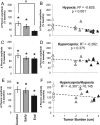Cancer cachexia impairs neural respiratory drive in hypoxia but not hypercapnia
- PMID: 30362273
- PMCID: PMC6438337
- DOI: 10.1002/jcsm.12348
Cancer cachexia impairs neural respiratory drive in hypoxia but not hypercapnia
Abstract
Background: Cancer cachexia is an insidious process characterized by muscle atrophy with associated motor deficits, including diaphragm weakness and respiratory insufficiency. Although neuropathology contributes to muscle wasting and motor deficits in many clinical disorders, neural involvement in cachexia-linked respiratory insufficiency has not been explored.
Methods: We first used whole-body plethysmography to assess ventilatory responses to hypoxic and hypercapnic chemoreflex activation in mice inoculated with the C26 colon adenocarcinoma cell line. Mice were exposed to a sequence of inspired gas mixtures consisting of (i) air, (ii) hypoxia (11% O2 ) with normocapnia, (iii) hypercapnia (7% CO2 ) with normoxia, and (iv) combined hypercapnia with hypoxia (i.e. maximal chemoreflex response). We also tested the respiratory neural network directly by recording inspiratory burst output from ligated phrenic nerves, thereby bypassing influences from changes in diaphragm muscle strength, respiratory mechanics, or compensation through recruitment of accessory motor pools.
Results: Cachectic mice demonstrated a significant attenuation of the hypoxic tidal volume (0.26mL±0.01mL vs 0.30mL±0.01mL; p<0.05), breathing frequency (317±10bpm vs 344±6bpm; p<0.05) and phrenic nerve (29.5±2.6% vs 78.8±11.8%; p<0.05) responses. On the other hand, the much larger hypercapnic tidal volume (0.46±0.01mL vs 0.46±0.01mL; p>0.05), breathing frequency (392±5bpm vs 408±5bpm; p>0.05) and phrenic nerve (93.1±8.8% vs 111.1±13.2%; p>0.05) responses were not affected. Further, the concurrent hypercapnia/hypoxia tidal volume (0.45±0.01mL vs 0.45±0.01mL; p>0.05), breathing frequency (395±7bpm vs 400±3bpm; p>0.05), and phrenic nerve (106.8±7.1% vs 147.5±38.8%; p>0.05) responses were not different between C26 cachectic and control mice.
Conclusions: Breathing deficits associated with cancer cachexia are specific to the hypoxic ventilatory response and, thus, reflect disruptions in the hypoxic chemoafferent neural network. Diagnostic techniques that detect decompensation and therapeutic approaches that support the failing hypoxic respiratory response may benefit patients at risk for cancer cachectic-associated respiratory failure.
Keywords: Breathing; Cancer; Chemoreflex and hypoxia.
© 2018 The Authors. Journal of Cachexia, Sarcopenia and Muscle published by John Wiley & Sons Ltd on behalf of the Society on Sarcopenia, Cachexia and Wasting Disorders.
Conflict of interest statement
The authors have no conflicts of interest to declare.
Figures






Similar articles
-
Relationships between tidal volume and phrenic nerve activity during hypercapnia and hypoxia.Acta Neurobiol Exp (Wars). 1973;33(1):419-25. Acta Neurobiol Exp (Wars). 1973. PMID: 4733050
-
Altered respiratory responses to hypoxia in mutant mice deficient in neuronal nitric oxide synthase.J Physiol. 1998 Aug 15;511 ( Pt 1)(Pt 1):273-87. doi: 10.1111/j.1469-7793.1998.273bi.x. J Physiol. 1998. PMID: 9679181 Free PMC article.
-
Ventilatory impairment in the dysmyelinated Long Evans shaker rat.Neuroscience. 2010 Sep 1;169(3):1105-14. doi: 10.1016/j.neuroscience.2010.06.010. Epub 2010 Jun 11. Neuroscience. 2010. PMID: 20542092 Free PMC article.
-
Hypoxia-induced phrenic long-term facilitation: emergent properties.Ann N Y Acad Sci. 2013 Mar;1279:143-53. doi: 10.1111/nyas.12085. Ann N Y Acad Sci. 2013. PMID: 23531012 Free PMC article. Review.
-
fMRI studies evaluating central respiratory control in humans.Front Neural Circuits. 2022 Sep 23;16:982963. doi: 10.3389/fncir.2022.982963. eCollection 2022. Front Neural Circuits. 2022. PMID: 36213203 Free PMC article. Review.
Cited by
-
Associations of Overall Survival with Geriatric Nutritional Risk Index in Patients with Advanced Pancreatic Cancer.Nutrients. 2022 Sep 15;14(18):3800. doi: 10.3390/nu14183800. Nutrients. 2022. PMID: 36145174 Free PMC article.
-
Low Muscle Mass and Radiodensity Associate with Impaired Pulmonary Function and Respiratory Complications in Patients with Esophageal Cancer.J Am Coll Surg. 2023 Apr 1;236(4):677-684. doi: 10.1097/XCS.0000000000000535. Epub 2023 Jan 5. J Am Coll Surg. 2023. PMID: 36728466 Free PMC article.
-
Feasibility and Efficacy of Inspiratory Muscle Training in Patients with Head and Neck Cancer receiving Concurrent Chemoradiotherapy.Asian Pac J Cancer Prev. 2021 Dec 1;22(12):3817-3822. doi: 10.31557/APJCP.2021.22.12.3817. Asian Pac J Cancer Prev. 2021. PMID: 34967560 Free PMC article.
-
An Estimation Formula for Resonance Frequency Using Sex and Height for Healthy Individuals and Patients with Incurable Cancers.Appl Psychophysiol Biofeedback. 2024 Mar;49(1):125-132. doi: 10.1007/s10484-023-09602-5. Epub 2023 Sep 13. Appl Psychophysiol Biofeedback. 2024. PMID: 37702816 Free PMC article.
-
Advanced High-Content Phenotypic Screening to Identify Drugs That Ameliorate the Inhibition of Skeletal Muscle Cell Differentiation Induced by Cancer Cachexia Serum.Pharmaceuticals (Basel). 2025 Mar 21;18(4):445. doi: 10.3390/ph18040445. Pharmaceuticals (Basel). 2025. PMID: 40283883 Free PMC article.
References
-
- Fearon K, Strasser F, Anker SD, Bosaeus I, Bruera E, Fainsinger RL, et al. Definition and classification of cancer cachexia: an international consensus. Lancet Oncol 2011;12:489–495. - PubMed
-
- Argilés JM, Busquets S, Toledo M, López‐Soriano FJ. The role of cytokines in cancer cachexia. Curr Opin Support Palliat Care 2009;3:263–268. - PubMed
-
- Zhou X, Wang JL, Lu J, Song Y, Kwak KS, Jiao Q, et al. Reversal of cancer cachexia and muscle wasting by ActRIIB antagonism leads to prolonged survival. Cell 2010;142:531–543. - PubMed
Publication types
MeSH terms
Grants and funding
LinkOut - more resources
Full Text Sources

